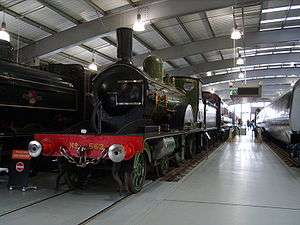LSWR T3 class
LSWR T3 class|

|
|
|
| Specifications |
|---|
| Configuration |
4-4-0 |
|---|
| UIC class |
2'Bn |
|---|
| Gauge |
4 ft 8 1⁄2 in (1,435 mm) |
|---|
| Leading dia. |
3 ft 7 in (1.092 m) |
|---|
| Driver dia. |
6 ft 7 in (2.007 m) |
|---|
| Length |
54 ft 2 3⁄8 in (16.52 m) |
|---|
| Height |
13 ft 2 3⁄4 in (4.03 m) |
|---|
| Axle load |
15.725 long tons (16.0 t) |
|---|
| Adhesive weight |
35.525 long tons (36.1 t) |
|---|
| Loco weight |
48.55 long tons (49.3 t) |
|---|
| Tender weight |
36.2 long tons (36.8 t) |
|---|
| Fuel type |
Coal |
|---|
| Fuel capacity |
3.00 long tons (3.05 t) |
|---|
| Water cap |
3,300 imp gal (15,000 l; 4,000 US gal) |
|---|
| Boiler pressure |
175 psi (1.21 MPa) |
|---|
| Cylinders |
Two, outside |
|---|
| Cylinder size |
19 in × 26 in (483 mm × 660 mm) |
|---|
|
|
|
| Career |
|---|
| Operators |
LSWR · SR |
|---|
| Class |
T3 |
|---|
| Power class |
SR: I |
|---|
| Withdrawn |
1930–1945 |
|---|
| Disposition |
One preserved, remainder scrapped |
|---|
|
The LSWR T3 class was a class of express passenger 4-4-0 steam locomotives designed for the London and South Western Railway by William Adams. Twenty were constructed between 1892–1893.
The class were numbered 557–576, and had been intended as a variant of the X2 class with slightly smaller driving wheels (6 ft 7 in or 2.007 m versus 7 ft 1 in or 2.159 m). In reality, the coupled wheelbase was lengthened by 6 inches (150 mm) and the locomotive was fitted with a firebox 6 feet 10 inches (2.08 m) deep – the largest firebox of any of Adams' designs.[1]
Table of locomotive orders
| Year | Order | Quantity | LSWR Numbers | Notes |
|---|
| 1892 | T3 | 10 | 557–566 | |
| 1893 | S5 | 10 | 567–576 | |
|
All passed to the Southern Railway at the grouping in 1923. Withdrawals started in 1930, and by the end of 1933 only three remained. No. 557 went in 1936, 571 in 1943, and the last, 563 was retired in August 1945 and set aside for preservation. Its permanent home is the Shildon Locomotion Museum in England. From May to October 2011 it was in Toronto, Ontario, on loan for use in a theatrical production of The Railway Children at Roundhouse Park, a role it reprised in January 2015 when the production was staged at Kings Cross, London.[2][3]
References
- Russell, J. H. (1991). A Pictorial Record of Southern Locomotives. OPC-Haynes. pp. 175–178.
External links
